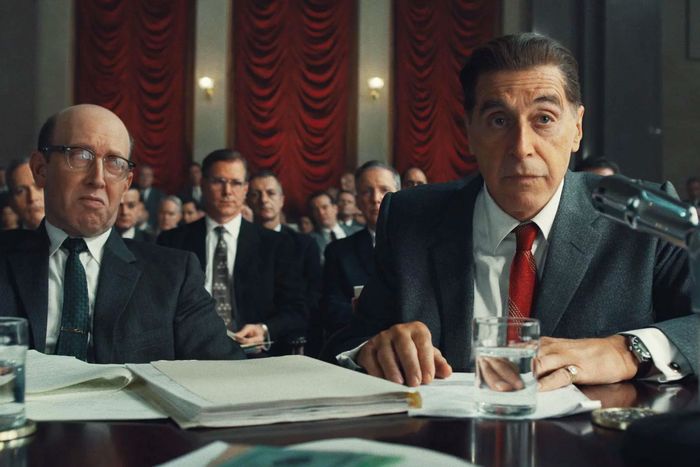
In the run-up to today’s world premiere of Martin Scorsese’s The Irishman, speculation understandably focused on the extensive de-aging technology used to transform Robert De Niro (current age: 76), Al Pacino (current age: 79), Joe Pesci (current age: 76), and some other members of the cast into younger versions of themselves throughout the film. Truth be told, many of us were worried — especially after some brief advance footage and a not-very-good trailer revealed a “young” De Niro with an eerily smooth sheen on his face.
So, how was the de-aging in The Irishman? It is, on one level, incredibly impressive – this isn’t just Young Jeff Bridges seen amid dark shadows in Tron: Legacy, or Young Carrie Fisher showing up briefly at the end of Rogue One. A good chunk of this three-and-a-half-hour epic (I’m not here to review the movie, but let the record state that I loved this movie) takes place between actors who are in reality nowhere near the ages they’re playing. One marvels at all the effort it must have taken to make this even remotely possible. That’s not just a technological accomplishment; it’s a strategic stroke of brilliance: So much of The Irishman involves de-aging that even if you’re not entirely on board with how these actors look, after a while you just kind of stop noticing, or at least minding. It might have been more problematic if you were watching a two-hour film that had, say, 20 or 30 minutes of shiny-faced de-aged actors.
Because yes, the actors do often still have that weird sheen on their faces. Especially De Niro. Perhaps because he’s playing a somewhat passive character — a guy who basically does what he’s told, and keeps quiet — so most of the time we’re focused on the tense, submerged expression on his face. By contrast, Al Pacino’s performance as Jimmy Hoffa is so broad — wild gestures, angry bellows with sharp detours into whispered asides, and oddly emphasized words — that you never really worry about whether the lines on his face seem too smooth or unreal. His whole presence is unreal, probably because he’s playing one of American history’s great larger-than-life figures.
But it’s not just the faces. You can make a seventy-something Robert De Niro look young (or at least, come somewhat close to it), but you can’t really make him act young. Especially for an audience that remembers what a young Robert De Niro did look like, and sound like, and move like. This issue of movement is something that Scorsese and his team were clearly aware of: At the post-film press conference, he and Al Pacino told a story about shooting a scene in which Pacino had to get up from his chair during an angry tirade about John F. Kennedy. Scorsese said he did a couple of takes, both of which looked great, and was ready to move on when his camera people and technical advisers reminded him that the 79-year-old Pacino’s character was supposed to be 49 in the scene. So the actor had to do the whole scene again, making sure to move like a much younger man. (“62!” they said after the next take. He got closer after that.)
There is something very poignant about all this, particularly in the case of De Niro, who in his heyday was an actor with a mythically powerful physical presence. When we imitate a Robert De Niro performance — and admit it, you and I both have — we imagine not just a voice and a face, but a series of gestures and steps and movements. Think of the whipsawing energy of Taxi Driver’s Travis Bickle, moody and reflective one minute, anxious and menacing the next. Think of the way his Jimmy Conway destroys that phone in Goodfellas (or the way he menacingly invites Lorraine Bracco to just mosey on down a dark alley to pick up some bootleg goods). Or those manic, adorable/creepy shoulder shrugs of The King of Comedy. Or the way he wields that baseball bat and puffs up his chest in The Untouchables. As he’s gotten older, De Niro has, like all humans, lost that versatility of movement, which has softened his unpredictability and intensity. Maybe this is why he often disappoints us. But it’s also why, in the right part, he can still shine, as he did in The Intern, and Silver Linings Playbook, and (fuck you) Dirty Grandpa.
The Irishman uses this very mortal limitation to its artistic advantage. It turns De Niro’s age and slowness into an existential ethos: Scorsese’s film is framed very much as the memories of an old man looking back on a life of violence and regrets — De Niro’s character sits in a wheelchair in a nursing home, mostly unresponsive, in the opening scene — it makes sense that the film’s version of “young” De Niro exists in this neither-here-nor-there space somewhere between youth and old age. This mimics the way memory often works: When we remember incidents from earlier in our lives, we imagine ourselves as younger versions of the people we are now, instead of the people we really were back then. As has already been memed to death, De Niro in The Irishman carries the same glower throughout the film, whether he’s a young man executing Nazis in World War II, a middle-aged man doing mob hits, or a geriatric man reflecting on his joyless, loveless, empty life. That’s sort of the point of the film.
Admittedly, this might have been a response on Scorsese’s part to technology that didn’t quite land where he initially hoped he would. But I’d argue that seeing the real Young Robert De Niro — the twitchy live-wire of Mean Streets, or the muscle-bound steamroller of Raging Bull — would have romanticized the character too much, threatening to undo Scorsese’s intentions here. He’s making a movie about a sad, old, impoverished world. The Irishman in that sense could be seen as the opposite of this summer’s The Lion King remake, which had mind-blowing effects that ultimately wound up working against the film’s emotional effect. It was technologically dazzling, but ultimately lifeless. The effects in The Irishman are far from perfect, but they actually help give the movie its soul.




